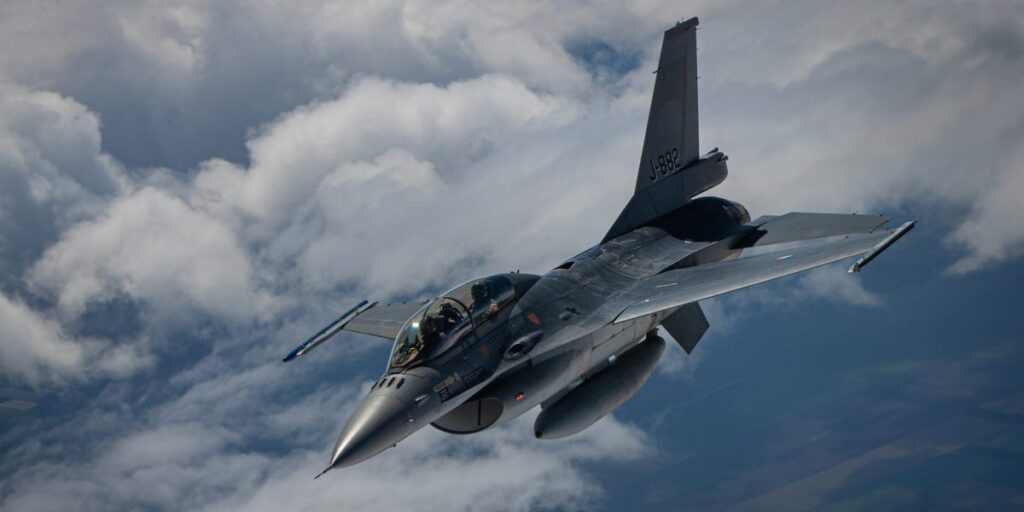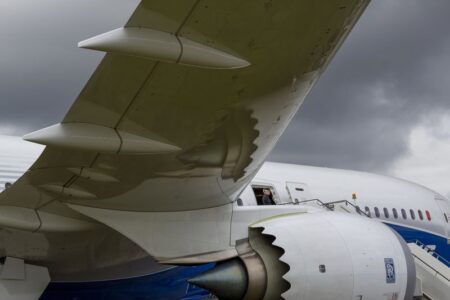- Ukraine needs more trained pilots to effectively build a reliable F-16 fighter fleet.
- Training more pilots gives Ukraine options, but bottlenecks hinder the program.
- A challenge is that its partners don’t appear to have enough pilot training spaces available.
Ukraine desperately needs more trained pilots to effectively build a formidable F-16 fighter fleet, air warfare experts told Business Insider.
Training bottlenecks among Ukraine’s international partners risk leaving the country with more jets than trained pilots, and with a limited number of pilots in training, there’s no choice, no opportunity to find the best. There’s no room for error should one struggle to overcome the challenges of flying a fighter very different from the Soviet-designed jets Ukraine knows best.
Michael Bohnert, a RAND Corporation analyst, said that integrating F-16s, or any new type of jet, into an air force “takes a lot of effort, time, training, and money that often gets overlooked. A lot of people think: ‘Oh, just give them the hardware and everything’s okay.’ Well, no.” The hardware really is only part of what it takes to build a fighter fleet.
Retired US Army Maj. Gen. Gordon ‘Skip’ Davis, who served as NATO’s deputy assistant secretary-general for its Defense Investment Division, said that for Ukraine’s F-16 program, told BI “the big issue is really the number of trained Ukrainian pilots.”
Training bottleneck
F-16 training for Ukraine’s pilots is being done by a coalition of countries, including the Netherlands, Canada, Denmark, the US, and Romania. The process, however, doesn’t appear to be as smooth as it probably could be.
Bohnert said that “there have been concerns around all of the different bottlenecks that we’re seeing, including the training spaces and things like that, where even if more F-16s had been committed to Ukraine at this point, that doesn’t necessarily mean that it could have more of them in the air.”
Norway, Belgium, and the Netherlands, Denmark have pledged more than 85 F-16 jets to Kyiv, but Ukraine can only field as many jets as the country has trained pilots.
The total number of trained Ukrainian pilots and those still undergoing training is not officially known, but there are indications that the number is not enough for Ukraine’s needs.
Politico reported in June that Ukraine’s Western partners did not have the number of training spaces that Ukraine wanted for its pilots. It reported that 30 Ukrainian pilots were ready for training, but the US training program could not accept them all.
The report said that a total of 20 Ukrainian F-16 pilots were expected to graduate by the end of this year — half of what a former US defense official said Ukraine would need to operate a full squadron of jets.
A Ukrainian lawmaker accused the US of “deliberately delaying” training and creating a situation where there would be “fewer trained pilots than fighter jets.”
Ukrainian President Volodymyr Zelenskyy then said in August, when the first F-16s arrived in his country, that Ukraine did not have enough trained pilots or enough of the jets themselves. “The number of F-16s we have in Ukraine, the number of pilots who have already been trained, is not enough,” he said.
Other partners appear to have training restrictions, too.
Danish Defense Minister Troels Lund Poulsen said in June that his country would stop training Ukrainian pilots on the fourth-generation F-16s after this year and instead focus on building its fleet of fifth-generation F-35s. That raises questions about the Ukrainian pilots in the training pipeline and opportunities.
George Barros, a Russia analyst at the Insitute for the Study of War, told BI that the number of airframes Ukraine has is limited, “and then the biggest limiting factor are the trained humans, the pilots that actually fly the planes.”
“There’s a huge pilot training bottleneck,” he said.
Getting the best pilots
Bohnert said the way to ensure Ukraine has the best pilots flying its new jets without delaying getting the F-16s in the sky is to train more pilots and be ruthless about cutting the ones who do not nail the training.
Ukraine’s F-16s, jets that were first manufactured by General Dynamics before that task later passed to Lockheed Martin, represent a challenge for Ukraine’s pilots, who have to overcome old habits and muscle memory associated with flying the kind of Soviet-designed jets that exclusively made up Ukraine’s air force before the F-16s arrived.
Ukrainian pilots were given around nine months of training, but most Western pilots are given three years to learn the jets, according to The Associated Press. That’s not a lot of time to adapt to a completely new jet that is much more sensitive with fly-by-wire controls instead of hydraulic ones.
Likely not every pilot is up to the task, and that’s a problem. “When you train someone who’s a great pilot in one plane and transition ’em to a new plane, it’s a hard change for a lot of people,” Bohnert said, explaining that the solution is to “put more pilots through training.”
He said that there’s a need to “get a higher number and be pretty clear that it’s okay to wash half the out and say: ‘Sorry, you’re not good enough. You need more time.'”
Bohnert said Ukraine’s partners would ideally have three pilots being trained for every aircraft. It’s not clear how many pilots are being trained for each of the F-16s promised to Ukraine, but it appears short of that expectation.
Training to that level of excess, Bohnert said, would give Ukraine options and lighten what is already a heavy load as it builds its new fighter fleet.
F-16s comes with challenges
Air warfare experts expect the F-16s to be a big boost for Ukraine, but they have cautioned that they likely won’t be game-changers.
Ukraine is receiving a smaller number than what its leadership and partners say it needs to be able to take risks, like the West does, and challenge Russia’s larger, more capable air force.
Bohnert said the number of F-16s Ukraine is getting from its partners is “definitely not enough.” Zelenskyy said in May that his air force needed about 120 to 130 advanced fighter aircraft to challenge Russia in the air.
The challenges that Ukraine’s armed forces face have been exacerbated by the delay in their arrival, many warfare experts have said. Ukraine asked for the jets soon after Russia launched its full-scale invasion, but the US long refused to budge.
The wait for permission to come gave Russia time to prepare and meant programs like training could not begin earlier.
The F-16s that Ukraine is receiving are also older models that don’t come with the latest upgrades and don’t quite stack up against some of Russia’s best jets.
Ukraine’s F-16 fighters, despite being capable combat-proven platforms, are a generation behind the newest fighters, like the F-35s the US and its allies are operating or Russia’s Su-57s, and they would likely be outmatched by some of the fourth-gens like Russia’s Su-35s. And without the stealth capabilities of the fifth-gen jets, it’s also vulnerable to modern Russian surface-to-air missile systems.
Bohnert said Ukraine’s newly acquired F-16s, which the US Air Force says cost somewhere between $14 million to $18 million, are “older airframes with not a lot of life left,” though he said that “doesn’t mean they’re bad.” It just limits what’s possible.
Experts say that the jets, despite their limits, will help Ukraine, particularly against incoming drone and missile attacks.
Gordon said that ultimately “they are making a difference now, and more and more will help them make more of a difference.”
Read the full article here
















